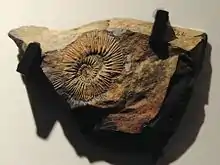Kepplerites
Kepplerites is a moderately evolute ammonite from the lower Callovian (upper Middle Jurassic) included in the Stephanoceratoidea.
| Kepplerites | |
|---|---|
 | |
| Kepplerites japonicus from Japan | |
| Scientific classification | |
| Kingdom: | |
| Phylum: | |
| Class: | |
| Subclass: | |
| Order: | |
| Superfamily: | |
| Family: | |
| Genus: | Kepplerites [2] Neumayr & Uhlig, 1892 |
Inner whorls are finely ribbed and have a flattened or grooved venter, the outer whorl has a rounded venter with smooth ribs that cross from side to side without interruption.
Kepplerites is assigned to the Kosmoceratidae and to the subfamily Keppleritinae. Gulielmina and Seymourites are closely related genera, sometimes regarded as subgenera of Kepplerites.
Kepplerites was named by Neumayr and Uhlig in 1892. The type species K keppleri is from Germany. This genus has also been found in Alaska, British Columbia, Madagascar, and Russia.
Biostratigraphic significance
The International Commission on Stratigraphy (ICS) has assigned the First Appearance Datum of the genus Kepplerites as the defining biological marker for the start of the Callovian Stage of the Jurassic, 166.1 ± 1.2 million years ago.
References
- Sepkoski, Jack (2002). "A compendium of fossil marine animal genera (Cephalopoda entry)". Bulletins of American Paleontology. 363: 1–560. Archived from the original on 2008-05-07. Retrieved 2017-10-18.
- "Paleobiology Database - Kepplerites". Retrieved 2017-10-19.
- Arkell et al., 1957. Mesozoic Ammonoidea; Treatise on Invertebrate Paleontology, part L, Ammonoidea. Geological Soc. of America and Univ. Kansas Press.
- Kepplerites illustrated in jsdammonites
